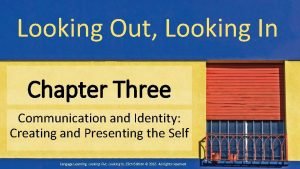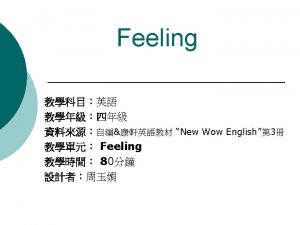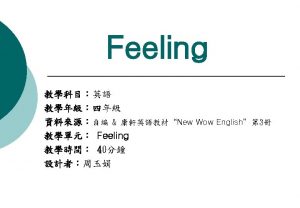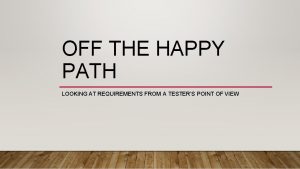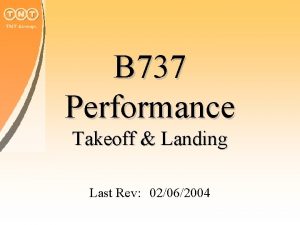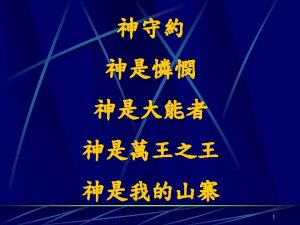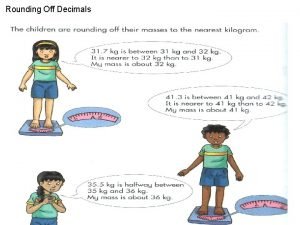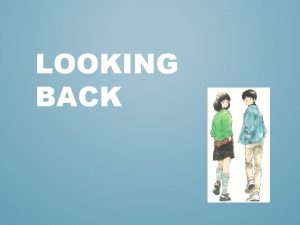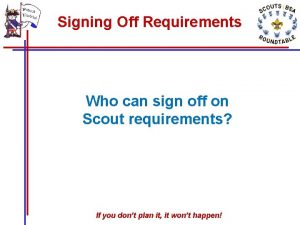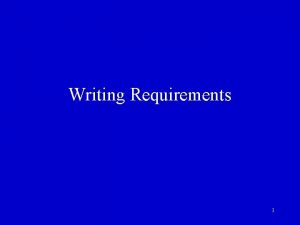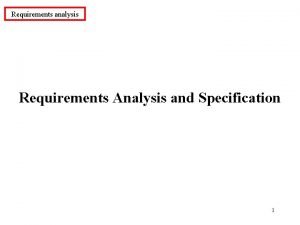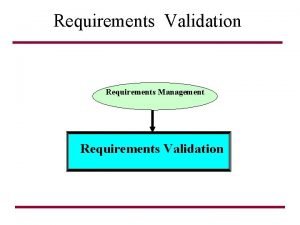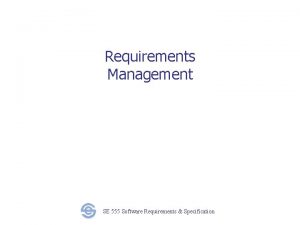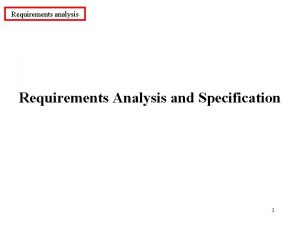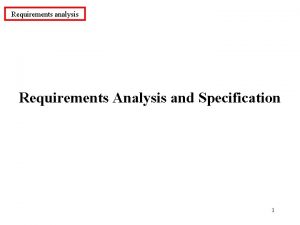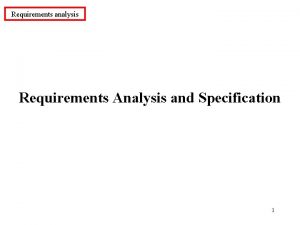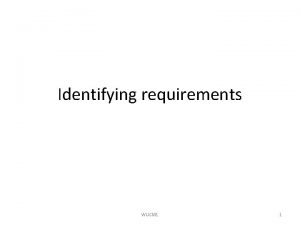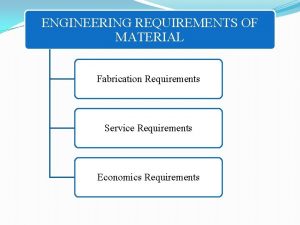OFF THE HAPPY PATH LOOKING AT REQUIREMENTS FROM




























- Slides: 28

OFF THE HAPPY PATH LOOKING AT REQUIREMENTS FROM A TESTER’S POINT OF VIEW

PRESENTATION ABSTRACT Let’s face it, there are more things that you want the application NOT to do then to do. As a tester, it’s my job to figure out how to gain access to all the unmarked paths surrounding the happy path and locate gaps in requirements and not forget those pesky bugs. As the rest of the team focuses on positive requirements and positive paths through the application, I look at all of the negative requirements and negative paths where the gaps and bugs live. Come explore with me as I share tips on how to create requirements that keep your tester (and users) traveling down the happy path.

TEAM MEMBER FOCUS • Project Manager/Product Owner focus is what is in scope. • Business Analysts focus on determining and documenting what the customer wants to achieve based on what is in scope. • Customer focus is to get their job done in the easiest way possible. • Developers focus on creating a solution that bring the requirements to life while staying in the boundaries set by the scope. • Quality Assurance focus on verifying that the requirements are all satisfied and application does not do anything unexpected.

POSITIVE: SOMETHING I WANT TO HAPPEN. Picture Source: http: //www. crossingitaly. net/travel/wp-content/uploads/Beach-holidays. jpg

HAPPY PATH Happy path is meant to describe the ideal process, without any exceptions or alternate paths. Architect Solutions The problem with the “Happy Path”

POSITIVE REQUIREMENTS • Support the business by being present. • Documented “What” the business needs/wants • Acceptance Criteria • The application SHALL/Must… • Standards • Performance • Security • Regulatory

Positive Requiremen t 1 Positive Requiremen t 2 Positive Requiremen t 3 Positive Requiremen t 4 HOW TO BUILD A HAPPY PATH Positive Requiremen t 5 Positive Requiremen t 6

NEGATIVE: SOMETHING I DON’T WANT TO HAPPEN Image Source: https: //www. doovi. com/video/lego-shark-attack/l. Qc. OEQXv. NKU

NEGATIVE REQUIREMENTS • Supports the business by NOT being present. • Implied “What” the business does not want • Non-Manager will NOT be able to… • The application SHALL NOT/MUST NOT… • Violation of Standards • Application Crashes • Does not limit access to Private Information (PI)

Negative Requirement Negative Requirement Positive Requiremen t Positive Requiremen t Negative Requirement Negative Requirement NEGATIVE REQUIREMENTS AND THE HAPPY PATH

“THE PRINCIPLE OBJECTIVE OF SOFTWARE TESTING IS TO GIVE CONFIDENCE IN THE SOFTWARE. ” – ANONYMOUS

POSITIVE TESTING Verify that the application does what is expected.

NEGATIVE TESTING Verify That The Application Doesn’t Do Anything Unexpected. https: //archuletavenue. files. wordpress. com/2011/09/cartoon_woman_at_work_with_her_computer_on_fire_royalty_free_clipart_picture_090604 -161121837042. jpg

SCRIPTED TEST Definition: Tests that are created based on requirements/standards where documentation is completed before testing begins. Purpose: Test the known • Test positive requirements • Test negative requirements Execution: Manual or Automated

SCRIPTED TEST EXAMPLE Positive Requirement: As a Manager, I want to be able to reassign a work item to the department director I report to, so that it can be escalated. Positive Scripted Test: Logged in as a manager, I can reassign a work item to my department director. Negative Scripted Test: • Logged in as a manager, I can not reassign a work item to a department director that I do not directly report to. • Logged in as a manager, I can not reassign all my work items to my department director. • Logged in as a manager, I can not reassign a work item to a manager. • Logged in as a customer service rep, I can not reassign a work item to my department director.

“More than the act of testing, the act of designing tests is one of the best bug preventers known. The thinking that must be done to create a useful test can discover and eliminate bugs before they are coded – indeed, test-design thinking can discover and eliminate bugs at every stage in the creation of software, from conception to specification, to design, coding and the rest. ” – Boris Beizer

EXPLORATORY TESTING Definition: Manual testing that systematically explores the application to gain a deeper understanding of the functionality of the application around the boundaries of requirements/standards. Purpose: Test the “space” between and around the positive and negative requirements/scripted test. • Find less obvious tests that need documented. • Identify missing requirements, creative interpretations of requirements or inconsistencies in functionalities. Execution: Manual

ADHOC TESTING (BUG HUNTING) Definition: Free flowing manual testing that explores the application outside of the boundaries of requirements/standards. Purpose: Identify fringe cases and bugs that are off the expected user paths. Execution: Manual

Positive Negative Positive Scripted Test Positive Scripted Test Positive Requirement Positive Requirement Negative Requirement Negative Scripted Test Negative Scripted Test Negative Scripted Test Exploratory Test Negative Scripted Test Exploratory Test Negative Scripted Test Exploratory Test ADHOC TEST Negative Scripted Test Exploratory Test

MARKETING CASE STUDY Marketing wants to send out a targeted marketing letters to all active accounts for State of Confusion 457 plan that have not had a contribution in 6 months or more to encourage people to save more for retirement. Positive Requirements: • Identify all Great State of Confusion 457 accounts that have not had a contribution in six months or longer that are in Active status. • Generate a mail file that contains: Account Type, Account Status, Name, Address, City, State, Zip, Date of last deposit, Gender

MARKETING CASE STUDY Positive Scripted Tests: • Great State of Confusion accounts with an Account Status of “A” and last contribution date that is exactly 6 months prior to current date is included in the file. • Great State of Confusion accounts with an Account Status of “A” and last contribution is 6 months and 1 day prior to current date is included on the file. • Mail file contains: Account Type, Account Status, Name, Address, City, State, Zip, Date of last deposit, Gender

MARKETING CASE STUDY Negative Scripted Tests: • Great State of Confusion accounts with an Account Status of “A” with last contribution date that is 5 months and 31 days prior to current date is not included in the file. • Great State of Confusion accounts with an Account Status of “C” for closed are not in file. • Great State of Confusion accounts with an Account Status of “P” for in payout are not included in the file. • Non-Great State of Confusion accounts with an Account Status of “A” and last contribution date that is exactly 6 months prior to current date is included in the file. • Non-Great State of Confusion accounts with an Account Status of “A” and last contribution of 6 months and 1 day prior to current date is included on the file.

MARKETING CASE STUDY Exploratory Testing Looking for answers to questions about functionality that are not covered by positive requirements. • What about accounts that have pending activity such as contributions, distributions or loans? • What about account identified for Escheatment (unclaimed funds)? • What about accounts that have a known bad address? • What about accounts that have a hold reason code?

MARKETING CASE STUDY Exploratory testing discovered missing requirements that stopped the mailing of marketing material to people who were not eligible to make contributions. Reason Code indicates if there is a hold on the account. • A = Active • D = Deceased • L = Legal Hold • H = General hold on account • M = Military Deployment • S = Separation from employment • No code = Active

TERMS AND DEFINITIONS • Positive Requirements: Supports the business by being present. • Negative Requirements: Supports the business by NOT being present. • Positive Scripted Tests: Documented tests that test Positive Requirements • Negative Scripted Tests: Documented tests that test Negative Requirements • Exploratory Testing: Manual testing that systematically explores the application to gain a deeper understanding of the functionality of the application around the boundaries of requirements/standards. • ADHOC Testing: Free flowing manual testing that explores the application outside of the boundaries of requirements/standards.

AGILE AND HAPPY PATH The reality is that “Agile” is not “Anti-Waterfall”, “Agile” is “Anti-Happy Path”. Agile is about recognizing that at the start of a project we are at our moment of maximum ignorance. It’s about embracing the fact that the act of developing software shines a light into the domain and uncovers hidden corners and edges. It’s about realizing that trips off the happy path aren’t exceptions, the happy path is the exception. Richard Dalton http: //www. devjoy. com/2014/02/the-happy-path-model-of-software-development/

PRESENTER PROFILE Cindy Hufnagle has 20 years of experience working in Information Technology in the roles of business analyst, software quality assurance, project manager, risk analyst, data management analyst, technical trainer and technical writer. She speaks at professional conferences to encourge people to think and understand concepts so they have a greater understanding of the why we do things. Linkedin: https: //www. linkedin. com/in/cindy-hufnagle-pmp-mba-psm-1 -61878811 Email: cynhufnagle@gmail. com

REFERENCES • Adrian Reed: Debate: The Danger of "Negative" Requirements –August 24, 2012 https: //www. techwell. com/techwell-insights/2012/08/debate-danger-negative-requirements • Architect Solutions -http: //www. architechsolutions. com/ • BA Times - https: //www. batimes. com • PM Times - https: //www. pmtimes. com • Richard Dalton The “Happy Path Model” of software development http: //www. devjoy. com/2014/02/the-happy-path-model-of-software-development/ • Sean M Everett What is a “Happy Path”? Thinking about user experience in an entirely new light https: //humanizing. tech/what-is-a-happy-path-2 c 62959 b 6 d 21 • Tidal. Shift Inc - http: //www. tidalshift. ca
 I am happy you are happy
I am happy you are happy Looking out looking in chapter 3
Looking out looking in chapter 3 Looking out looking in chapter 9
Looking out looking in chapter 9 Happy angry sad
Happy angry sad Happy sad hungry
Happy sad hungry Gecko orthotics
Gecko orthotics Angry i guess
Angry i guess Happy path test
Happy path test Unity signalr
Unity signalr 02062004 color
02062004 color Elbows off the table fingers off the food song
Elbows off the table fingers off the food song Tư thế ngồi viết
Tư thế ngồi viết Hát kết hợp bộ gõ cơ thể
Hát kết hợp bộ gõ cơ thể đặc điểm cơ thể của người tối cổ
đặc điểm cơ thể của người tối cổ Mật thư anh em như thể tay chân
Mật thư anh em như thể tay chân Tư thế worms-breton
Tư thế worms-breton Tư thế ngồi viết
Tư thế ngồi viết ưu thế lai là gì
ưu thế lai là gì Thẻ vin
Thẻ vin Cái miệng bé xinh thế chỉ nói điều hay thôi
Cái miệng bé xinh thế chỉ nói điều hay thôi Thơ thất ngôn tứ tuyệt đường luật
Thơ thất ngôn tứ tuyệt đường luật Các châu lục và đại dương trên thế giới
Các châu lục và đại dương trên thế giới Từ ngữ thể hiện lòng nhân hậu
Từ ngữ thể hiện lòng nhân hậu Diễn thế sinh thái là
Diễn thế sinh thái là Slidetodoc
Slidetodoc V cc cc
V cc cc 101012 bằng
101012 bằng Chúa yêu trần thế
Chúa yêu trần thế Hươu thường đẻ mỗi lứa mấy con
Hươu thường đẻ mỗi lứa mấy con

